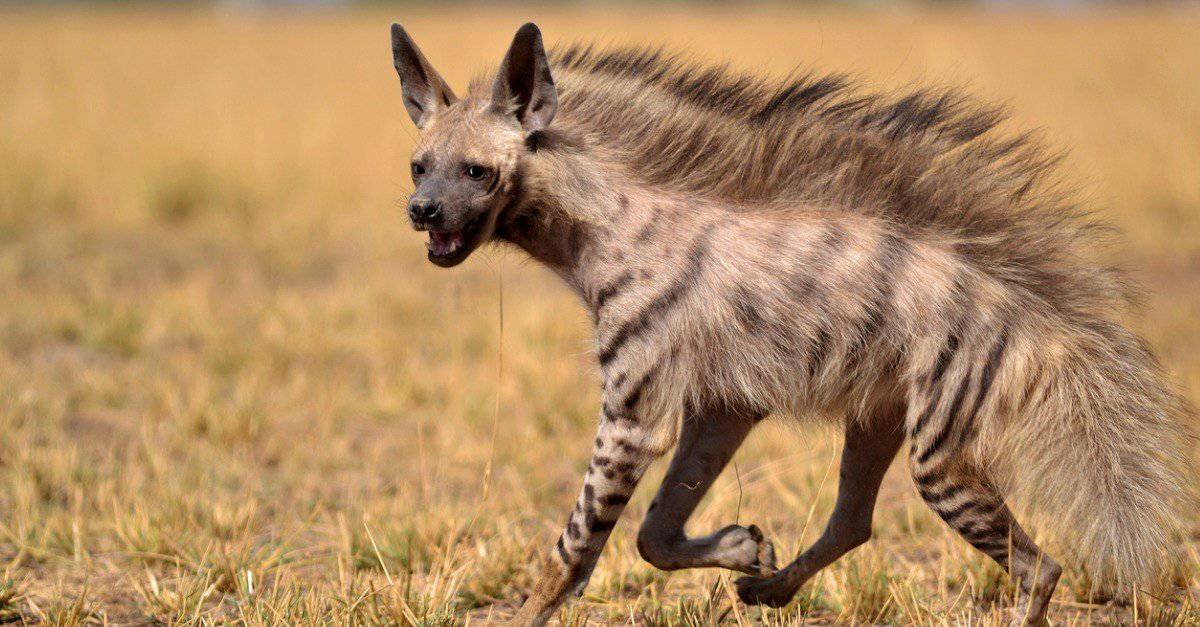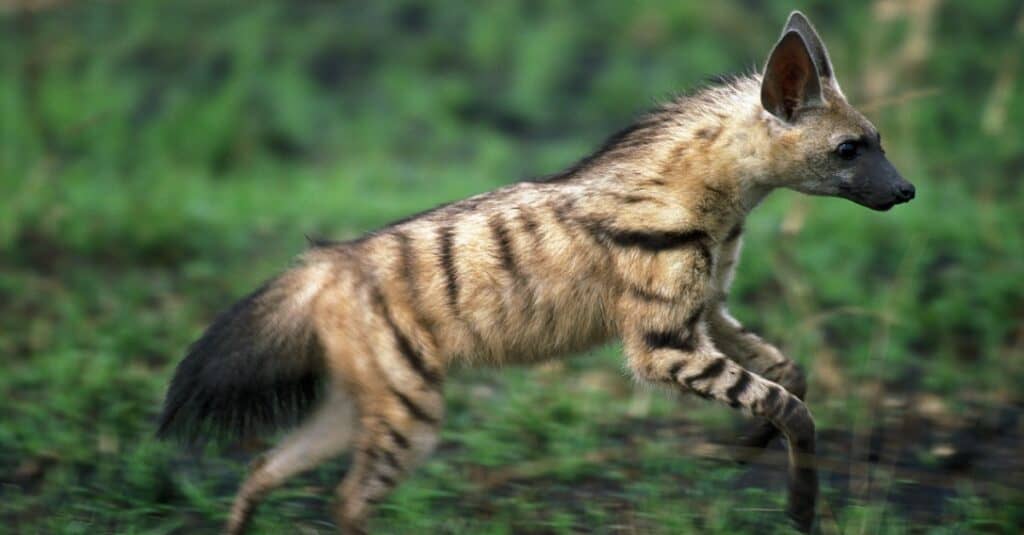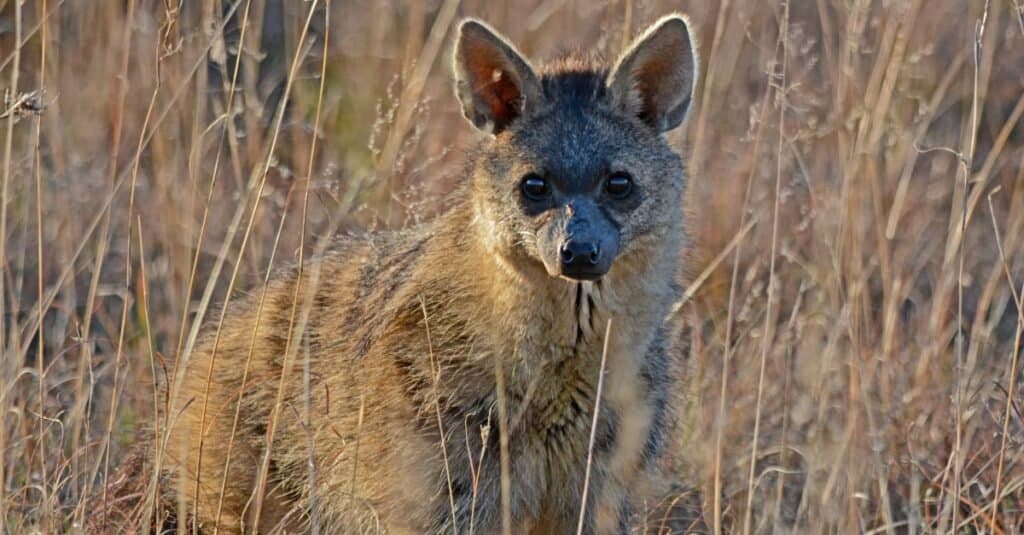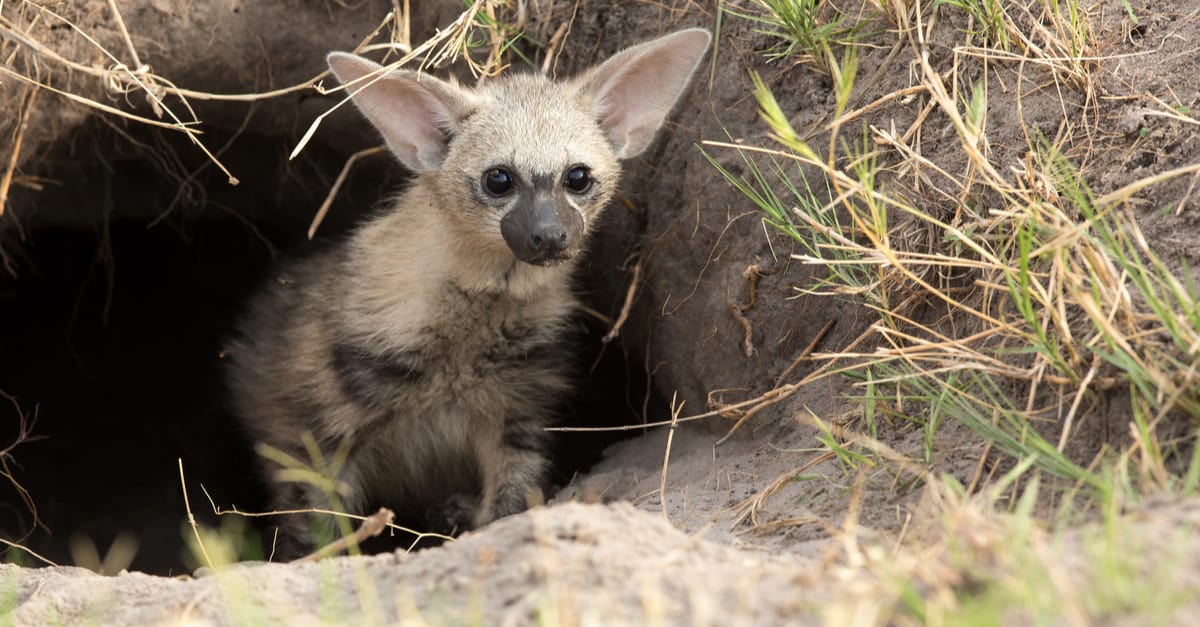The aardwolf is the lesser-known cousin of the striped, brown, and spotted hyenas. Because it’s shy, elusive, and nocturnal, it’s rarely encountered by people.
The name aardwolf essentially means earth wolf in the Afrikaans and Dutch languages, but this is misleading because it’s not a wolf at all. Instead, it belongs to the hyena family, a fact which is fairly obvious from its appearance alone. It looks quite a bit like a striped hyena, whose African habitat overlaps with its own.
Aardwolf vs Hyena
As just mentioned, the aardwolf is a member of the hyena family, and its appearance is quite similar to a hyena. The main differences are that the aardwolves are generally smaller in body size, they live in smaller groups of family units, and they consume insects rather than carrion or larger prey.

3 Incredible Aardwolf Facts!
- Because aardwolves are specifically adapted for eating termites, some of their teeth have evolved into blunt pegs, barely even capable of chewing meat. Their powerful jaws are used to defend territory instead.
- An alternative name for this species is maanhaar-jackal, which means mane-jackal in Dutch, even though it isn’t closely related to jackals at all.
- Aardwolves are territorial and will raise their manes as a warning sign to an intruder, then chase it away! The situation rarely ends in a fight.
Scientific Name
The scientific name of the aardwolf is Proteles cristata. The genus name Proteles, which essentially means “complete in front” in Greek, refers to the fact that it has five toes on the front limbs and only four on the hind limbs. Cristata comes from a Latin word that means a comb or tuft on the head of an animal (referring to its luxurious mane).
There are two subspecies of the aardwolf: Proteles cristatus cristatus lives in Southern Africa, and Proteles cristatus septentrionalis lives in eastern and northeastern Africa.
Together with the brown hyena, spotted hyena, and striped hyena, the aardwolf is a member of the family Hyaenidae. It was once placed in its own separate family, but this is no longer considered to be correct.
Evolution
Aardwolves are thought to be an example of a “primitive” hyena. This essentially means they may have evolved from a very early branch of the hyena family before the other three species came to be. Based on genetic and fossil evidence, they probably diverged from the rest of the hyena family at some point between 15 and 32 million years ago. It was once thought that the aardwolf may not be a hyena at all, but rather a closely related species mimicking the appearance of the striped hyena to trick potential predators, but this explanation has fallen out of favor as scientists have gathered more evidence.
Appearance

The aardwolf might be accidentally mistaken for a hyena if you don’t know what key identification markers to look for. The most prominent feature is the strong dark stripes against a backdrop of brown or yellow fur with additional black markings around the feet, tail, and muzzle. It also has a thick mane running from the head to the tail and large triangle-shaped ears. However, compared with most hyenas, it also has five toes on the front feet instead of four. Most members of the species are about three feet long and weigh between 17 to 31 pounds. This makes them the smallest member of the hyena family. Males and females look almost identical in coloration and size.
Habitat

The aardwolf prefers to inhabit dry open savannas and grasslands with minimal annual rainfall. It can be found in two separate disconnected places, thus the two subspecies have developed from the separation: the eastern horn of Africa around Ethiopia, Somalia, and Kenya, and the southern portion of Africa around Angola, Zambia, and South Africa. There is some debate about whether these eastern and southern populations should be considered as entirely separate subspecies because apart from their distinctive ranges, they are otherwise similar.
Predators and Threats
The aardwolf faces few significant threats in the wild because they generally keep to themselves and don’t bother humans too often. However, sometimes they are in danger of falling victim to hunting, motor accidents, and habitat loss from encroaching human habitats.
What Eats the Aardwolf?
Adult aardwolves have few serious predators in the wild, but the aardwolf puppy is vulnerable to jackals, lions, leopards, and other hyenas. Hunting dogs will also sometimes attack and kill the aardwolf.
What Does the Aardwolf Eat?
Aardwolves may look like fearsome predators, but their diet consists almost solely of termites.
Reproduction and Life Cycle

The aardwolf’s mating season can conceivably take place at any time of the year, but depending on where it lives, breeding often peaks in the rainy months. To attract a potential mate, both males and females will secrete a pungent scent from the anal gland. If the female accepts what the male has to offer, then they will form pair bonds together and produce a single litter per year. However, the most aggressive males may intrude on another territory and copulate with the mate of a weaker male as well.
After a gestation period lasting approximately 90 days, the mother will give birth to a litter of two to five pups with their eyes open but otherwise helpless. They will remain safe and protected in the underground den, feeding on the mother’s milk for the first three to four months of their lives. The father has the responsibility of guarding the den, while the mother will make foraging trips outside. When the offspring are fully weaned, each puppy will be fed regurgitated termites until they’re old enough to hunt on their own.
These foraging trips become progressively bolder and farther from the den with each passing month. The aardwolf puppy will continue to learn and grow under the supervision of the parents for the first year. After that, they leave the family to stake out their territory. Most aardwolves achieve full sexual maturity at around 1.5 to two years of age. The lifespan of the aardwolf isn’t exactly known, but other closely related hyena species can live about 15 years or more in the wild.





